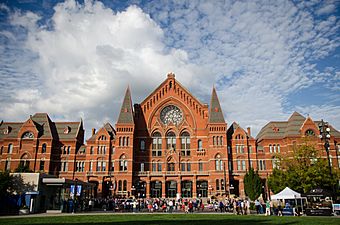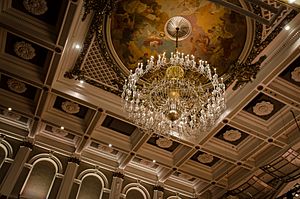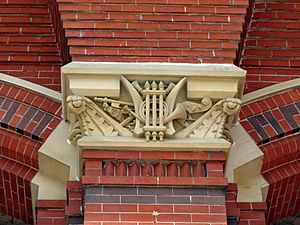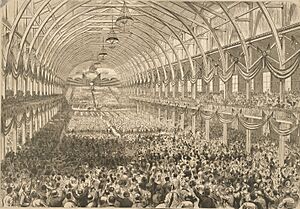Cincinnati Music Hall facts for kids
 |
|
 |
|
| Address | 1241 Elm Street Cincinnati, Ohio United States |
|---|---|
| Coordinates | 39°6′34″N 84°31′8″W / 39.10944°N 84.51889°W |
| Public transit | |
| Operator | Cincinnati Arts Association |
| Capacity | 2,289 (Springer Auditorium) 1,300 (Ballroom) |
| Construction | |
| Built | 1876–1878 |
| Opened | 14 May 1878 |
| Renovated | 1969–1975, 2016–2017 |
| Tenants | |
| Cincinnati Ballet Cincinnati Opera Cincinnati Pops Orchestra Cincinnati Symphony Orchestra May Festival Chorus |
|
|
Cincinnati Music Hall
|
|
| Architect | Hannaford, Samuel, & Sons |
| Architectural style | Venetian Gothic |
| MPS | Hannaford, Samuel, & Sons TR |
| NRHP reference No. | 70000496 |
| Significant dates | |
| Added to NRHP | January 26, 1970 |
| Designated NHL | December 2, 1974 |
Cincinnati Music Hall is a famous building in Cincinnati, Ohio. It was finished in 1878. It's home to many amazing groups. These include the Cincinnati Ballet, Cincinnati Symphony Orchestra, Cincinnati Opera, May Festival Chorus, and the Cincinnati Pops Orchestra.
In 1975, it became a National Historic Landmark. This means it's a very important historical place. It's known for its special Venetian Gothic architecture style. The building was made for two main things. It hosted music shows in its main hall. It also held big industrial shows in its side areas.
Music Hall is located at 1241 Elm Street. It's right across from Washington Park. This area is called Over-the-Rhine, close to downtown Cincinnati.
The Music Hall was built over an old cemetery. This has led to stories that it is one of the most haunted places in America.
In 2014, Music Hall was listed as one of "America's 11 Most Endangered Historic Places." This list is made by the National Trust for Historic Preservation. The building was closed for over a year for a big renovation. It cost $143 million. Music Hall reopened in 2017, looking better than ever.
Contents
Exploring Music Hall's Spaces
Music Hall has several different areas inside. Each one is used for different kinds of events.
Springer Auditorium
Springer Auditorium is the main performance hall. It is named after Reuben Springer, who helped pay for the building. This auditorium can hold 2,289 people for symphony concerts. For the Cincinnati Pops, it can hold 2,439 people.
Springer Auditorium is the home for many groups. These include the Cincinnati Symphony Orchestra, the Cincinnati Pops Orchestra, the Cincinnati Ballet, and the Cincinnati Opera. It also hosts the May Festival. This festival was a big reason why the hall was built.
The auditorium also has a huge chandelier. This beautiful piece came from Czechoslovakia in the early 1970s. It weighs about 1,500 pounds and is 21 feet wide. It has 96 lights, each like a candle.
Music Hall Ballroom
The Music Hall Ballroom is a large space for events. It can hold up to 1,300 people. It is almost 20,000 square feet in size. This makes it the second-largest meeting space in Cincinnati.
People use the Ballroom for many events. These include big parties, art shows, fashion shows, and school reunions. It's also used for breakfast, lunch, and dinner events.
The Ballroom has been updated many times. A big renovation happened in 1998. In 2007, a special "Mighty Wurlitzer" organ was brought to the Ballroom. This organ used to be in an old theater in Cincinnati.
Corbett Tower
Corbett Tower is a space on the third floor. It was first called Dexter Hall. It was named after a member of the Music Hall building team. This area was once used for performances by the College of Music of Cincinnati.
Later, Corbett Tower was used for radio and TV broadcasts. In 1972, it was renovated and renamed. It honors J. Ralph and Patricia Corbett, who supported Music Hall for a long time.
Today, Corbett Tower is used for many events. These include weddings, parties, and fancy dinners. It can seat up to 200 people. It has a stage, sound and light systems, and a dance floor.
Wilks Studio
Wilks Studio is a new space. It was added during the 2016-2017 renovation. It's a flexible room that can be used for many things. It works as a rehearsal room or an event space.
Wilks Studio can seat up to 200 people. It's used for weddings, parties, and meetings. Both the Cincinnati Symphony Orchestra and Cincinnati Opera use it for rehearsals and small shows.
Other Areas
Music Hall also has other important spaces. The Taft Suite is a private room. It holds restored parts of an old organ. The Music Hall Foyer is a large gathering area. It's used before shows and for private events.
Building Design and Style
Cincinnati Music Hall was designed by architect Samuel Hannaford. It is a great example of the Victorian Gothic Revival Style. This style has steep roofs and special brickwork. It also has fancy windows and a large Rose Window on the front.
The building is actually made of three separate parts. There's Music Hall in the middle. Then there's the North Exposition Building and the South Exposition Building on the sides. They are connected by walkways on the second floor. This allows events to use all three spaces.
Each building has unique stone carvings. These carvings show what each part was used for. The center Music Hall has musical instruments carved on it. The South Exposition Hall has flowers and birds, showing its history with plants. The North Exposition Hall has scientific tools, representing its mechanical past.
The building used to have very detailed brickwork. This included carved and painted designs. But during a renovation from 1969 to 1975, the outside was cleaned with sand. This sadly destroyed most of those special details.
A Look Back in Time
Music Hall has a long and interesting history.
Before Construction
In 1818, the city of Cincinnati bought the land where Music Hall now stands. In 1821, Ohio's first mental hospital was built there. Later, after a serious illness outbreak in 1832, the land was used as a cemetery for poor people.
By 1857, the city had grown too close to the cemetery. It was no longer a good place for it. So, in 1859, the city turned the land into a park called Elm Street Park. This park was used for big public shows until 1876. Then, it was given to the Music Hall Association.
Early Festivals and Shows
Cincinnati had its first big industrial show in 1869. It was a huge success. At the same time, German musicians planned a large temporary building. This was for a singing festival called the North American Saengerbund in 1870.
The two groups decided to build one shared building. It was sometimes called Exposition Hall or Saengerfest Hall.
Exposition Hall
Exposition Hall was a very large wooden building. It was 250 feet long, 100 feet wide, and 80 feet tall. It also had three other temporary buildings attached. The total space was over 108,000 square feet. This was even bigger than the 1853 World's Fair in New York City.
This hall was where the 1876 Republican National Convention took place. At this event, Rutherford B. Hayes was chosen to run for president.
A famous story tells of a thunderstorm during a May Festival performance in 1875. The rain on the tin roof was so loud that the music could not be heard. Reuben R. Springer, a wealthy man from Cincinnati, was in the audience. After that, he decided Cincinnati needed a better, permanent building for music.
Building the Hall
Springer was impressed by how much the music festivals and industrial shows helped the city. In 1875, he offered to donate $125,000. He had two conditions. First, the land had to be tax-free. Second, the community had to raise another $125,000.
When only $106,000 was raised, Springer gave an extra $20,000. He later offered another $50,000 if $100,000 more was raised. This extra money was for building the side wings for industrial shows. The total cost for Music Hall was over $300,000. The exposition wings cost an additional $146,000.
Construction began in 1876. The main Music Hall building was built first. There were some delays due to weather. But workers hurried to finish Music Hall before the 1878 May Festival.
After Music Hall was done, more money was raised. This allowed the North and South Exposition Halls to be completed. These two spaces were Cincinnati's main convention centers until the 1970s.
Grand Opening
The first performance at Music Hall was on May 14, 1878. About 6,000 people watched the opera "Alceste" and Beethoven's "Eroica" symphony. These shows were special because the May Festival Chorus and Cincinnati Opera moved into Music Hall as their new home. The North and South Exposition Halls were officially finished on September 2, 1879.
Famous Events and Performers
Music Hall has hosted many important guests and events. In 1879, President Ulysses S. Grant spoke there. The hall was packed with people. Other presidents like William McKinley, Theodore Roosevelt, Benjamin Harrison, and Dwight D. Eisenhower also visited.
In 1880, the Democratic National Convention was held at Music Hall. This is where Winfield S. Hancock was chosen to run for President. This event was also special because telegraph wires were added to Music Hall for the convention. This was new for large performance halls.
Many famous musicians have performed at Music Hall. These include Richard Strauss in 1904, Frank Sinatra in 1941 and 1993, and Ella Fitzgerald in 1956 and 1974. Johnny Cash performed in 1957 and 1981. Other stars like Ray Charles, Fats Domino, Janis Joplin, Grateful Dead, Pink Floyd, Miles Davis, Bruce Springsteen, and The White Stripes have also played there. B. B. King performed five times.
Before they had their own buildings, some Cincinnati groups were based in Music Hall. These included the Cincinnati Art Museum and the Cincinnati College of Music. The hall even had a roller skating rink for over 30 years!
From 2013 to 2016, the Cincinnati Symphony Orchestra put on a special show called Lumenocity. It used projection mapping, which is like projecting images onto the building. This show was very popular. It helped create a city-wide projection mapping event called Blink.
Recent Renovation
In 2016, Cincinnati Music Hall closed for 14 months. It had a $143 million renovation. The project added 30,000 square feet of new space. It also updated the old performance and event areas.
About half of the money for the renovation came from private donations. The other half came from public funds. These included money from the City of Cincinnati and tax credits from the State of Ohio. The renovated Music Hall officially reopened to the public on October 6-7, 2017. There was a weekend of performances and tours.
Haunted Stories
Many people believe Music Hall is haunted. Some employees have said they've had strange experiences there. Others say they haven't seen anything unusual.
Patricia K. Beggs, the CEO of the Cincinnati Opera, has said, "Ghosts? Um, yes. Indeed, there are Music Hall ghosts." Erich Kunzel, a conductor for the Cincinnati Pops, once said he met "people" (ghosts) when working late at night. He said they were friendly.
Stories of ghosts started even before Music Hall was built. This was when the ground was dug up for an elevator.
Music Hall has been featured on TV shows about haunted places. It was on The Travel Channel's Most Terrifying Places in America. It was also on the SYFY TV show Ghost Hunters.
See also
- List of concert halls
- List of opera houses
- List of reportedly haunted locations in the United States





